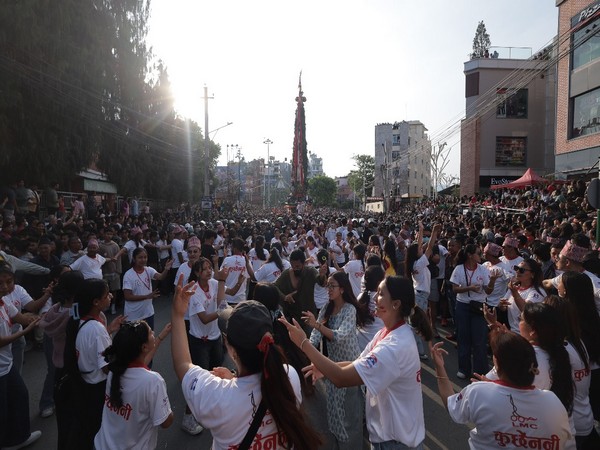Lalitpur [
Nepal
On May 1 (ANI), the Rato Macchindranath or Bunga Dugh chariot festival, a significant event in the Newar tradition, commenced.
Nepal
The most venerated festival has commenced in the historic city of Patan, Lalitpur, stretching through throngs of devotees on Thursday, marking its longest celebration yet.
chariot procession
of
Nepal
.
The festival celebrating the Rain God and harvest includes a massive 42-foot-tall chariot that carries the deity through the city streets, along with traditional music and religious ceremonies.
The festival has deep roots in
Nepal
This culture and folklore. As the legend goes, the
chariot procession
was started in 897 AD to commemorate Lord Macchendranath’s feat of bringing rain to the city of Patan after a severe drought. The festival celebrates the deity’s power to bring prosperity and rainfall to the region.
Each year, the Newa community builds the chariot employing wooden logs and age-old crafting techniques, entirely devoid of nails. This grand parade lasts more than a month and is accompanied by groups of musicians along with various traditional rites and customs.
“Preparations begin a month ahead. The jatra infuses liveliness and joyous times for us. It makes us delighted to participate and we conduct practice sessions to master playing the musical instruments, providing fulfillment and keeping the tradition alive,” explained Ujjwal, a member of the performance music group, to ANI.
Based on the lunar calendar, the most extended chariot festival takes place.
Nepal
starts on the fourth day of the bright fortnight of Bachhala, which is the seventh month in the lunar calendar
Nepal
The Sambat calendar. Nevertheless, this year it did not align with the established rules.
According to legend, the Kathmandu Valley experienced a severe drought with no rainfalls, necessitating the invocation of Lord Machendrajana.
Nepal
From Kamakhya in India, King Gubhaju of Bhaktapur, along with residents from Kathmandu and Jyapus from Lalitpur, embarked on a journey to fetch him. Once they brought forth the resolution to their issue, they worshiped the deity of rain and abundance through rituals.
chariot procession
,” Ujjwal added.
A well-known tale relates that when Guru Gorakhnath visited the town of Patan, he was not recognized by its inhabitants. Since the locals neither provided him with sustenance nor paid attention to his presence, Guru Gorakhnath imprisoned all the snakes. Given that these “Naags”—the serpent deities associated with rainfall—were detained by Guru Gorakhnath, Patan faced severe water shortages due to the ensuing drought.
The king of Patan at that time, Narendra Deva, requested his counselors to fetch Lord Machhindranatha, the guru of Gorakhnath, from Assam. Upon learning of the sage’s arrival in the town, Guru Gorakhnath rose from his position, allowing the snakes to escape, thus bringing forth rainfall to the city and concluding the period of scarcity.
The Rato Machhindranath festival is essential for
Nepal
features the city’s cultural legacy, highlighting Nepal’s vibrant traditions and customs. Despite disruptions from the 2015 earthquake and the COVID-19 pandemic, the event has restarted, infusing joy and vitality into the community of Patan.
It is believed that the people of Bhaktapur have the power to bring the chariot back to their city and house the deity for six months if the procession does not occur prior to Dashain, which is the significant two-week festival celebrated locally.
Nepal
in the month of October. (ANI)
Provided by Syndigate Media Inc. (
Syndigate.info
).
